POSSESSION/FORM
By Andrew Maerkle
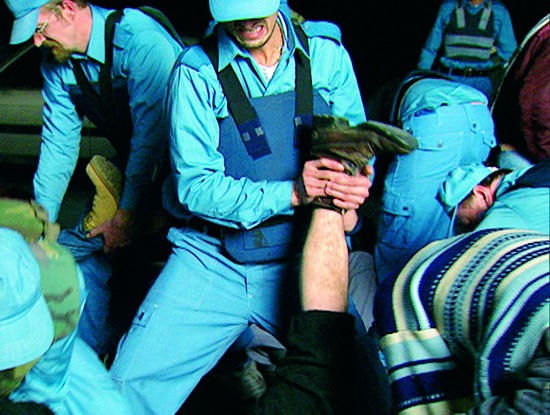
Still from Glutinosity (2001), single-channel video installation. All images: courtesy Aernout Mik and carlier❘gebauer, Berlin.
Aernout Mik’s meticulously staged, multi-channel videos explore the tensions between individual actions and collective order, hysteria and reason, and how these constantly shifting tensions never manifest quite where we assume them to be. Previous works have depicted the trading floor during a stock-market crash; the site of a bus accident; scenes of riots; but it’s never quite clear to what degree these are enactments or whether they in fact record actual incidents. The videos are often subtly augmented by quasi-architectural modifications to the exhibition space that, in disturbing conventions of viewing, further blur the boundaries between fiction and reality.
What the works consistently communicate, however, is a sense of crisis, occuring at both an intimate, bodily scale as well as across broad social dimensions. ART iT recently met with Mik to learn more about how he balances a formal interest in behavioral situations with the potentially political message of drawing attention to what the artist describes as the intense bizareness of seeing normality and extremity going hand-in-hand.
I. When Walking is Walking
Aernout Mik on the Polish writer Witold Gombrowicz, mimetic sympathy and form.
ART iT: You are known for videos exploring scenarios in which the rules of typical behavior collapse and reason and hysteria collide together. Thus I was interested to learn that you were deeply inspired by the Polish-born writer Witold Gombrowicz, who explored similar themes in his novels. What was it that attracted you to Gombrowicz’s writing?
AM: I must say I haven’t read Gombrowicz in 15 or 20 years, but it’s true that when I started working in art I was very intrigued by the ideas in his writing: physical relations that are created between things, forms that are created through relationships, and this affinity for incidental relationships that gain meaning through repetition; also, the form denying force that is related to youth. All of this comes together in his central question; does the form create us or do we create the form?
What appeals most strongly to me about Gombrowicz, and what became a very active force in my work is what might be called a “traveling” from one object or person to the other through connections that are created almost by accident. This also happens in my work when the camera travels from body parts to objects and objects to other objects or when people assume each other’s compulsive movements and emotions. There is an action of contamination or spreading out that becomes an independent force. This is a visual element in the videos, but viewers also experience it in the space as something that almost goes by itself toward them and affects them just by being there. The visual becomes a tactile thing.
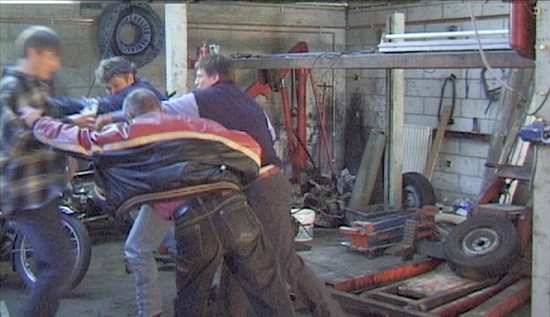
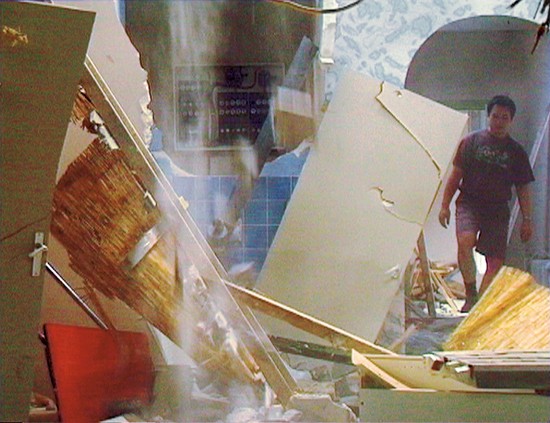
Top: Still from Garage (1998), single-channel video installation. Bottom: Still from Softer Catwalk in Collapsing Rooms (1999), single-channel video installation.
ART iT: Many reviewers of your exhibitions mention this effect, how after leaving they experience reality almost as a continuation of the artwork.
AM: I often hear about this as well. In order to achieve an interaction that shifts between the fictional space and actual space, there’s a kind of continuous trembling from one level to the other.
There’s this beautiful scene that Gombrowicz describes in his diary, where he’s in the tram and looking at the neck of someone standing in front of him. Then he realizes that he has been looking at the neck for just a bit too long. At that moment he is somehow trapped. The neck becomes something in itself. It separates itself from the body, connects with other necks and takes him on a road that he can’t stop. Through his accidental gaze, the neck is in a way dismembered. It becomes something that, even if he wants to avoid it, he’s already reacting to and is therefore dependent upon. That is a powerful thing, this independent force that connects things, that defines what’s taking place and pulls you in its own direction.
ART iT: In that sense Gombrowicz’s writing is less psychological than it is self-aware. He’s observing himself from the outside, not the inside.
AM: Yes. The word dismembered is very strong for me. It’s almost shamanistic. It’s not about finding the essence of something or revealing its identity. It’s a kind of observation of fragmentation that is not about being psychologically obsessed with oneself, but rather spreads out along the sensorial and cognitive networks we simultaneously inhabit, that constitute us. We are cumulatively a collection of body parts.
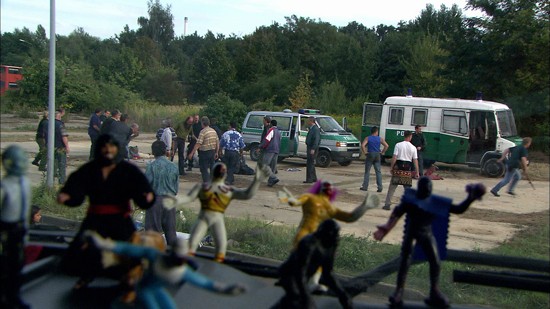
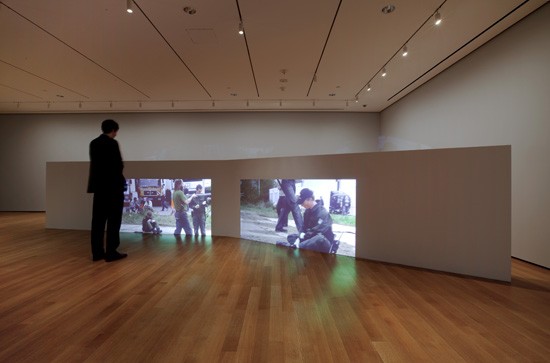
Top: Set photograph from Training Ground (2006), two-channel video installation; photo Florian Braun. Bottom: Installation view of Training Ground at the Museum of Modern Art, New York, 2010; photo Jason Mandella.
ART iT: As you discuss this I see how these ideas play out in your video works, but how about your early sculptural installations? It seems there’s a surprising continuity between the two periods. In installations such as Für nichts und wieder nichts (1992), you mixed diverse elements together in space such that they had a specific synergy, but that synergy was also somehow disturbing.
AM: There’s a strong gap where my interest moved from an almost decontextualized physical presence in space to a super-contextualized presence in a clearly social collective body. But indeed in both cases there’s a split in the space: it’s no longer a continuous space. The affect between bodies and objects is approached in a very physical way. There are always jumps that make it impossible to experience the environment as a whole, even if there’s a continuing mimetic chain between things. One body starts to develop a mimetic sympathy to another body, and begins to look like or behave like that other body, and then again with another body.
There’s a film by the French filmmaker and ethnographer Jean Rouch, Les maître fous (1953), in which this is very much taking place. [Shot in Accra, Ghana, the film is a quasi-fictional documentary of practitioners of the Hauka movement, who mimicked the pomp and ceremonies of their colonial suppressors in order to gain their powers.] In the ritual there is a constant crossing of social boundaries, with the performers driven by the desire to overcome or subvert power hierarchies by assuming the energy of the suppressors through mimicking them. As with Gombrowicz, there is a mechanism of contagion or contamination.
I was really impressed by the analogy to some elements in my own work and decided to cite Rouch’s film in my video Training Ground (2006), although I never explained this to the people with whom I was working. I like this idea in Rouch’s film of the ritual, and of performance that is simultaneously extremely serious and intense as well as theatrical and artificial. As with Les maître fous, there is both a documentary and a fictional side to my work. There’s a spontaneity or loss of control in the action that becomes documentary, but there’s also still an obvious artificiality, even when I use found footage. They both seem to operate very closely together.
ART iT: I found this was also the case with the work Raw Footage (2006), made with discarded stock footage shot by international camera crews in the 1990s during the wars in Yugoslavia. One begins to doubt whether the footage is real, because in its utter banality it’s far beyond what we’re conditioned to see by the media. It becomes both fictional and yet more real at the same time.
AM: Yes. There’s of course an aspect of making something more real by taking viewers out of their normal way of experiencing information. There’s initially a kind of disconnection and then the moment you connect with the material, you experience it first as unreal, even though it is perhaps more real. The main two strategies of this work were to recover a time that is closer to a real time interval compared with how we normally consume information, and to include as well the unexciting off-moments in the footage that are normally cut out in the editing process. The “event” is no longer fully isolated in time and space, but surrounded by an equally important periphery.
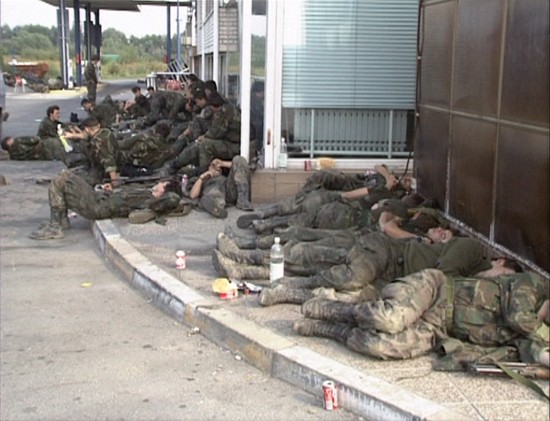
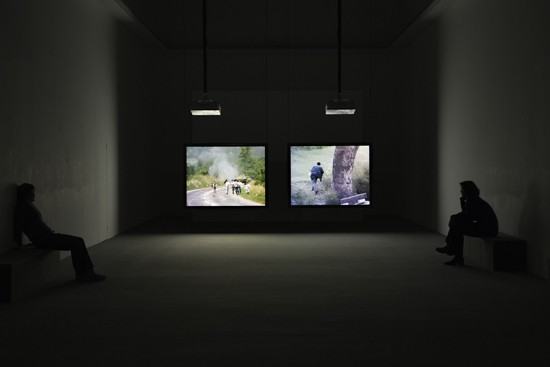
Top: Still from Raw Footage (2006), two-channel video installation with sound. Bottom: Installation view of Raw Footage at Kunstverein Hannover; photo Raimund Zakowski.
ART iT: Do you often use source material, as in Training Ground and Raw Footage? Is that a regular part of your practice?
AM: No, not always. Of course I collect source material, but in many of the works I try to be a kind of amateur or generalist. I’m trying to relate to subjects in order to understand how they are set in our collective memory – not how they really are, but how we think they are, or the projections we make about them.
With Raw Footage, I did not study the war in Yugoslavia in particular, prior to making the work. When I was collecting the material, I didn’t want to know exactly who is who and what is what. Of course there were many things I already knew about the war, and it wasn’t that I wanted to deny them. But I wanted to see the entire situation freshly from a different perspective. I was interested in the structure itself of one group suppressing another, quite similar, group – they were all neighbors – and in a certain mirroring between victim and oppressor: the impossibility of distinguishing one and the other when all the borders collapse; the impossibility of deciding where the war is and where it is not. I wanted to articulate these uncertainties rather than to dissect and fix them into particular identities.
I had the feeling that when you’re actually in these situations, you never know exactly where the war is. And in a sense, Raw Footage is not only about war, it’s also about our whole world, and its ongoing conditions of uncertainty. As in Raw Footage, much of our lives actually consist of waiting and hanging around.
ART iT: But when you talk about not researching the specifics of Yugoslavia, isn’t there a danger that you could turn the material into a purely formal investigation?
AM: I don’t think it’s formalist. I’m looking at what the material contains without starting from a symbolically loaded perspective. These imprinted categories paradoxically prevent you from connecting with what is taking place: there’s a certain person standing somewhere and waiting for a while, or you see two soldiers walking to the front and the camera follows them a bit too long – again this recalls Gombrowicz – and the moment it’s too long, it’s no longer a situation of two soldiers only walking to the front, it becomes a video also about walking, and the walking is just the walking. That these two things, going to the front and just walking, are taking place at the same time is part of the intense bizarreness of what is happening. Extremity and normality are going hand in hand.
That’s also why I tried to use the longest takes possible, in order to create through the rhythm of the piece the kind of rhythm that follows more the viewer’s own experience of time. This is of course the exact opposite of how we normally get our information through the media, which is completely disrupted and disconnected, and can only be related to as a representation. I found that many people were emotionally touched after seeing Raw Footage, possibly much more so than if they had seen the actual news item cut from the same footage.
Aernout Mik: Possession/Form
